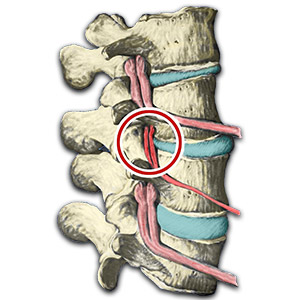Patient with Neck Surgery Still Able to be Helped by Chiropractic According to Study
A case study published on February 4, 2023, in Cureus, and on the U.S. National Library of Medicine's National Center for Biotechnology Information documented the improvement under chiropractic care of a patient suffering from neck pain who had previously had significant neck surgery.
Neck surgery is a serious procedure. There is ongoing discussion in healthcare concerning the effectiveness of neck surgery in the long term. Studies have shown that patients who seek chiropractic care first for musculoskeletal pain such as neck or back pain, are less likely to have spinal surgery. However, there are many patients who receive spinal surgery first, and only seek chiropractic care after ongoing problems cannot be resolved medically.
 In
this case, a 66-year-old woman sought chiropractic care due
to her incapacitating neck pain. The woman also had a
significant head tilt and was suffering with muscle spasms
and headaches. She was getting progressively worse over the
prior six months and received no relief from the
acetaminophen and tramadol she was taking, or the physical
therapy she was receiving.
In
this case, a 66-year-old woman sought chiropractic care due
to her incapacitating neck pain. The woman also had a
significant head tilt and was suffering with muscle spasms
and headaches. She was getting progressively worse over the
prior six months and received no relief from the
acetaminophen and tramadol she was taking, or the physical
therapy she was receiving.
The woman's history showed that, at age 14, she suddenly developed severe neck pain, torticollis, and headaches which were made worse by sneezing or neck movements and were slightly better if she held her head with her hands. She was eventually diagnosed with "rotatory instability" of the top two bones in her neck. She was first unsuccessfully treated using 24-hour halo traction for six months. She was then placed in a body cast which ran from her head to her hips, leaving only her face exposed for an additional six months. However, she continued to get worse. She did not receive, nor was she offered any chiropractic care at that time.
Finally, by age 16, the girl received neck fusion surgery of the first and second bone in the neck. After the surgery, the girl experienced severe bilateral lower extremity weakness and was unable to walk, requiring the use of a wheelchair for three months. By six months after the surgery, the girl had reportedly made a slow but near full recovery. She continued to have some abnormal sensations in the lower half of her body and in her legs.
Years later at age 60, the woman tripped and fell. Afterwards, she developed neck pain, headaches, and involuntary jerking neck movements. These problems continued to get worse, even resulting in a visit to the ER. None of the medications or therapies she received over the next few years seemed to help, so she finally decided to seek chiropractic care.
After a chiropractic examination
and CT scans of her neck, specific and appropriate forms of
chiropractic care were started. After only one week of care,
the patient reported that her pain reduced on a 1 to 10
scale, from a 7/10 down to only a 3/10. Additionally, the
sensation she was having in her lower body had disappeared.
After only three weeks of chiropractic care, the woman
reported complete resolution of her headaches, and near
complete resolution of her neck pain. A follow-up
examination three months later showed that the woman had
maintained her overall improvement.
In their conclusion the authors wrote, "This case presents an older woman with chronic progressively worsening neck pain and headache and a history of posterior surgical fusion of C1/2 who improved with multimodal chiropractic therapies including SMT."
 One
of the reasons noted for language delay can be hearing loss
caused by otitis media with effusion (OME). This is a
condition where fluid collects in the middle ear without any
signs or symptoms of an acute ear infection, and typically
develops after there has been an acute ear infection with
fever and pain.
One
of the reasons noted for language delay can be hearing loss
caused by otitis media with effusion (OME). This is a
condition where fluid collects in the middle ear without any
signs or symptoms of an acute ear infection, and typically
develops after there has been an acute ear infection with
fever and pain. There
have been many cases where a patient has gone to a
chiropractor after an automobile accident and their x-rays
showed a loss of neck curvature. In most of these cases,
x-rays were taken after the accident so it was difficult to
prove that the accident caused the loss of neck curve as
opposed to the curve having been reduced prior to the
accident.
There
have been many cases where a patient has gone to a
chiropractor after an automobile accident and their x-rays
showed a loss of neck curvature. In most of these cases,
x-rays were taken after the accident so it was difficult to
prove that the accident caused the loss of neck curve as
opposed to the curve having been reduced prior to the
accident.  Although
the term "subluxation" may have slightly different
interpretations in the medical field when compared to
chiropractic, the chiropractic profession uses this term
more than all others. The more exact term, vertebral
subluxation, is meant to not just mean a bone out of proper
alignment in the spine, but also the neurological effects of
the spinal misalignment. Given the vast number of mechanisms
the subluxation can affect on human physiology, the most
exact term using in chiropractic is the "vertebral
subluxation complex."
Although
the term "subluxation" may have slightly different
interpretations in the medical field when compared to
chiropractic, the chiropractic profession uses this term
more than all others. The more exact term, vertebral
subluxation, is meant to not just mean a bone out of proper
alignment in the spine, but also the neurological effects of
the spinal misalignment. Given the vast number of mechanisms
the subluxation can affect on human physiology, the most
exact term using in chiropractic is the "vertebral
subluxation complex."